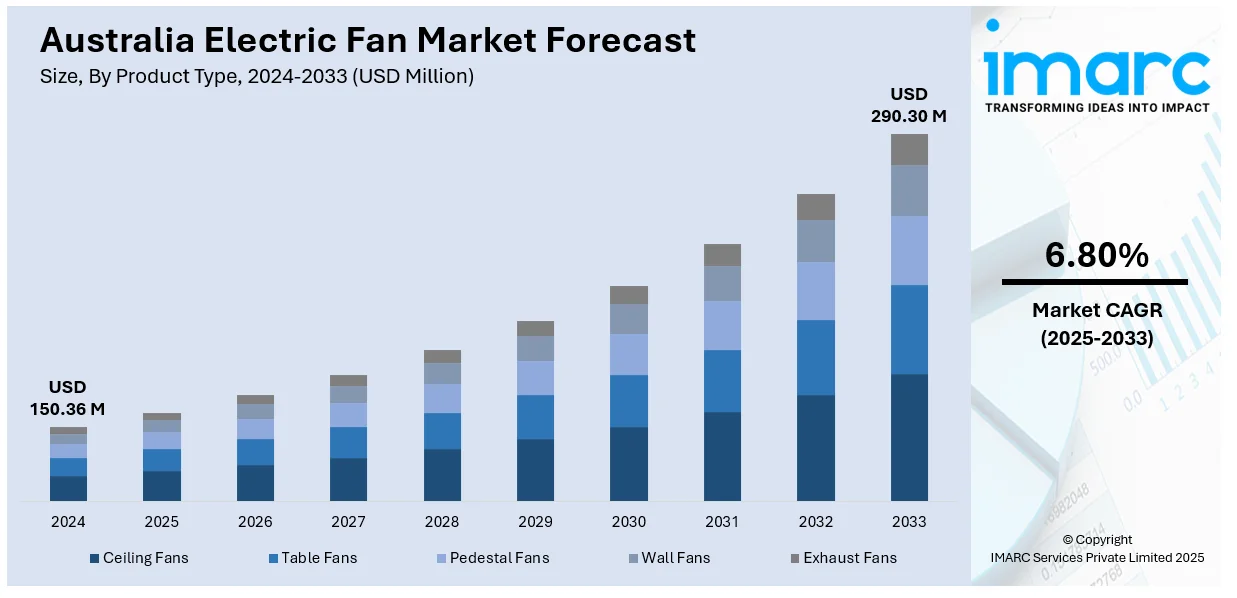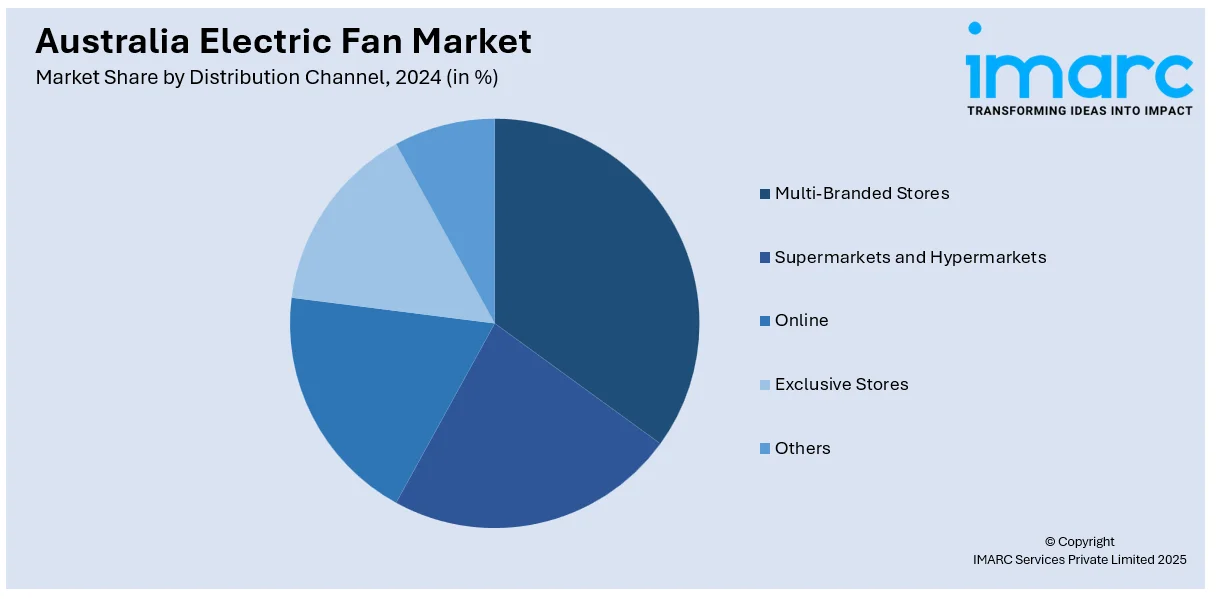
Australia Electric Fan Market Size, Share, Trends and Forecast by Product Type, Distribution Channel, End User, and Region, 2025-2033
Australia Electric Fan Market Overview:
The Australia electric fan market size reached USD 150.36 Million in 2025-2033. Looking forward, IMARC Group expects the market to reach USD 290.30 Million by 2033, exhibiting a growth rate (CAGR) of 6.80% during 2025-2033. Rising temperatures, increased energy efficiency awareness, and the demand for affordable cooling solutions are primary drivers of the market. Urbanization, smart home integration, and consumer preference for sustainable products further boost demand. These dynamics contribute significantly to the rising Australia electric fan market share.
|
Report Attribute
|
Key Statistics
|
|---|---|
|
Base Year
|
2024 |
|
Forecast Years
|
2025-2033
|
|
Historical Years
|
2019-2024
|
| Market Size in 2024 | USD 150.36 Million |
| Market Forecast in 2033 | USD 290.30 Million |
| Market Growth Rate 2025-2033 | 6.80% |
Australia Electric Fan Market Trends:
Smart Fan Integration and Home Automation
The integration of electric fans with smart home ecosystems is gaining momentum in Australia. Consumers increasingly demand connectivity features such as Wi-Fi, app-based control, and voice assistant compatibility with Alexa or Google Assistant. For instance, in April 2024, Martec launched the Elite DC Ceiling Fan, equipped with WiFi connectivity, six speed options, and a customizable LED light. Designed for both indoor and outdoor use, the fan combines enhanced performance with a sleek, contemporary look to suit modern living environments. These features allow users to control airflow, speed, and timer settings remotely, aligning with the country's growing adoption of IoT-enabled home appliances. Manufacturers are leveraging this trend by offering advanced BLDC (Brushless Direct Current) motor-based smart fans that provide both functionality and energy efficiency. As households become more tech-savvy, the alignment of ceiling and pedestal fans with automated systems enhances convenience and energy monitoring. This digital transformation supports not just consumer comfort but also efficiency goals, contributing to the overall Australia electric fan market growth through innovation and improved lifestyle integration.

To get more information on this market, Request Sample
Demand for Eco-Friendly and Energy-Efficient Models
Australia’s energy policies and sustainability efforts are pushing manufacturers to design environmentally friendly electric fans that align with energy-saving standards. For instance, as per industry reports, ceiling fans are increasingly being favored for their energy efficiency, typically consuming between 15 to 90 watts per hour, in contrast to air conditioners, which can require anywhere from 1,500 to 5,000 watts per hour. The preference for energy-efficient BLDC motor fans is rising, particularly among environmentally conscious consumers. These fans consume significantly less power while delivering equal or superior airflow compared to traditional AC motor variants. Additionally, rising electricity prices are prompting Australian households and commercial spaces to adopt fans as a low-cost cooling alternative to air conditioning. The push for carbon neutrality and reduced greenhouse gas emissions is also influencing procurement decisions in both residential and commercial sectors. This environmental emphasis is a crucial catalyst for Australia electric fan market growth, with energy efficiency and green certification becoming key differentiators among leading brands.
Australia Electric Fan Market Segmentation:
IMARC Group provides an analysis of the key trends in each segment of the market, along with forecasts at the country and regional levels for 2025-2033. Our report has categorized the market based on product type, distribution channel, and end user.
Product Type Insights:
- Ceiling Fans
- Table Fans
- Pedestal Fans
- Wall Fans
- Exhaust Fans
The report has provided a detailed breakup and analysis of the market based on the product type. This includes ceiling fans, table fans, pedestal fans, wall fans, and exhaust fans.
Distribution Channel Insights:

- Multi-Branded Stores
- Supermarkets and Hypermarkets
- Online
- Exclusive Stores
- Others
A detailed breakup and analysis of the market based on the distribution channel have also been provided in the report. This includes multi-branded stores, supermarkets and hypermarkets, online, exclusive stores, and others.
End User Insights:
- Residential
- Commercial
- Industrial
A detailed breakup and analysis of the market based on the end user have also been provided in the report. This includes residential, commercial, and industrial.
Regional Insights:
- Australia Capital Territory & New South Wales
- Victoria & Tasmania
- Queensland
- Northern Territory & Southern Australia
- Western Australia
The report has also provided a comprehensive analysis of all the major regional markets, which include Australia Capital Territory & New South Wales, Victoria & Tasmania, Queensland, Northern Territory & Southern Australia, and Western Australia.
Competitive Landscape:
The market research report has also provided a comprehensive analysis of the competitive landscape. Competitive analysis such as market structure, key player positioning, top winning strategies, competitive dashboard, and company evaluation quadrant has been covered in the report. Also, detailed profiles of all major companies have been provided.
Australia Electric Fan Market News:
- In September 2024, Volution Group plc agreed to acquire Fantech Group in Australasia for AUD 280 Million. Fantech, a leader in residential and commercial ventilation in Australia and New Zealand, will strengthen Volution's regional presence. The acquisition supports Volution’s strategy of expanding in energy-efficient indoor air quality solutions.
- In April 2024, Modern Forms introduced a range of smart ceiling fan innovations, such as the Aura model with eight blades and built-in LED lighting, the oversized Size Matters fan with dimmable LEDs, the industrial-style Spinster fan with aerodynamic blades, and the Veloce fandelier. All models feature energy-efficient DC motors and are compatible with smart home systems.
Australia Electric Fan Market Report Coverage:
| Report Features | Details |
|---|---|
| Base Year of the Analysis | 2024 |
| Historical Period | 2019-2024 |
| Forecast Period | 2025-2033 |
| Units | Million USD |
| Scope of the Report | Exploration of Historical Trends and Market Outlook, Industry Catalysts and Challenges, Segment-Wise Historical and Future Market Assessment:
|
| Product Types Covered | Ceiling Fans, Table Fans, Pedestal Fans, Wall Fans, Exhaust Fans |
| Distribution Channels Covered | Multi-Branded Stores, Supermarkets and Hypermarkets, Online, Exclusive Stores, Others |
| End Users Covered | Residential, Commercial, Industrial |
| Regions Covered | Australia Capital Territory & New South Wales, Victoria & Tasmania, Queensland, Northern Territory & Southern Australia, Western Australia |
| Customization Scope | 10% Free Customization |
| Post-Sale Analyst Support | 10-12 Weeks |
| Delivery Format | PDF and Excel through Email (We can also provide the editable version of the report in PPT/Word format on special request) |
Key Questions Answered in This Report:
- How has the Australia electric fan market performed so far and how will it perform in the coming years?
- What is the breakup of the Australia electric fan market on the basis of product type?
- What is the breakup of the Australia electric fan market on the basis of distribution channel?
- What is the breakup of the Australia electric fan market on the basis of end user?
- What is the breakup of the Australia electric fan market on the basis of region?
- What are the various stages in the value chain of the Australia electric fan market?
- What are the key driving factors and challenges in the Australia electric fan market?
- What is the structure of the Australia electric fan market and who are the key players?
- What is the degree of competition in the Australia electric fan market?
Key Benefits for Stakeholders:
- IMARC’s industry report offers a comprehensive quantitative analysis of various market segments, historical and current market trends, market forecasts, and dynamics of the Australia electric fan market from 2019-2033.
- The research report provides the latest information on the market drivers, challenges, and opportunities in the Australia electric fan market.
- Porter's five forces analysis assist stakeholders in assessing the impact of new entrants, competitive rivalry, supplier power, buyer power, and the threat of substitution. It helps stakeholders to analyze the level of competition within the Australia electric fan industry and its attractiveness.
- Competitive landscape allows stakeholders to understand their competitive environment and provides an insight into the current positions of key players in the market.
Need more help?
- Speak to our experienced analysts for insights on the current market scenarios.
- Include additional segments and countries to customize the report as per your requirement.
- Gain an unparalleled competitive advantage in your domain by understanding how to utilize the report and positively impacting your operations and revenue.
- For further assistance, please connect with our analysts.
 Request Customization
Request Customization
 Speak to an Analyst
Speak to an Analyst
 Request Brochure
Request Brochure
 Inquire Before Buying
Inquire Before Buying




.webp)




.webp)












